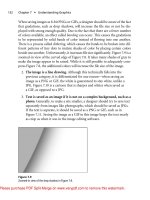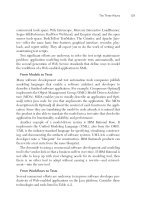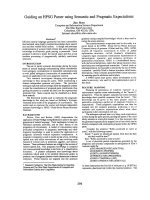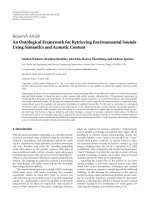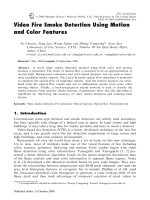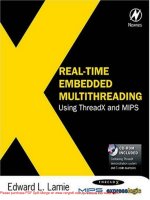Real-Time Embedded Multithreading Using ThreadX and MIPS- P4 pdf
Bạn đang xem bản rút gọn của tài liệu. Xem và tải ngay bản đầy đủ của tài liệu tại đây (148.86 KB, 20 trang )
MIPS Exception Handling 5 7
www.newnespress.com
There are several different ways to initialize the exception vector. You can set it up by
loading it directly to address 0x80000180 with a JTAG debug device. Alternatively, your
system may copy the exception vector to address 0x80000180 during initialization.
The exception vector handler is typically located in the ThreadX low-level initialization
fi le tx_initialize_low_level.S and may be modifi ed according to application needs. For
example, in many applications, the reset vector will actually point to some low-level
application code that is responsible for preparing the hardware memory for execution.
This code can also copy itself from fl ash memory to RAM if that is necessary for the
application. Note that ThreadX can execute in place out of fl ash memory or in RAM.
Once fi nished, the application low-level code must jump to the same location specifi ed in
the original reset vector.
For example, suppose a low-level initialization routine called my_low_level_init is
required to execute before anything else in the system. The application would have to
change the reset vector to point to the routine in Figure 6.3 .
.text
.globl _reset_vector # Address 0xBFC00000
_reset_vector:
mfc0 $8, $12
li $9, 0xFFBFFFFF # Build mask to clear BEV bit
and $8, $8, $9 # Clear BEV bit
mtc0 $8, $12 # Use normal vector area
lui $8, %hi(__start) # Build address of _start routine
addi $8, $8, %lo(__start) #
j $8 # Jump to _start
nop
.text
.globl _tx_exception_vector
_tx_exception_vector: # Address 0x80000180
la $26,_tx_exception_handler # Pickup exception handler address
j $26 # Jump to exception handler
nop # Delay slot
Figure 6.2: ThreadX vector area
Please purchase PDF Split-Merge on www.verypdf.com to remove this watermark.
58 Chapter 6
At the end of my_low_level_init , the code would have to branch (jump) to call the
original compiler startup code, as illustrated in Figure 6.4 .
6.2.1.1 Compiler Initialization
Shortly after the MIPS processor executes the reset vector, the system executes the
C compiler’s initialization code. In this example, the name of the compiler’s entry point is
__start . The C compiler initialization is responsible for setting up all application data areas,
including initialized and uninitialized global C variables. The C run-time library is also set
up here, including the traditional heap memory area. If some of the application code was
written in C ϩϩ , the initialization code instantiates all global C ϩϩ objects. Once the run-
time environment is completely set up, the code calls the application’s “ main ” entry point.
6.2.1.2 ThreadX Initialization
The ThreadX initialization typically occurs from inside the application’s main function.
Figure 6.5 shows a typical application main function that uses ThreadX. It is important to
www.newnespress.com
.globl _reset_vector # Address 0xBFC00000
_reset_vector:
mfc0 $8, $12 # Pickup SR
li $9, 0xFFBFFFFF # Build mask to clear BEV bit
and $8, $8, $9
# Clear BEV bit
mtc0 $8, $12
# Use normal vector area
lui $8, %hi(__my_low_level_init) # Build address of my init routine
addi $8, $8, %lo(__my_low_level_init)
j $8 # Jump to _start
nop
Figure 6.3: Changing the reset vector
.globl my_low_level_init
_my_low_level_init
lui $8, %hi(__start)
# Build address of _start
routine
addi $8, $8, %lo(__start) #
j $8 # Jump to _start
nop
Figure 6.4: ThreadX low-level initialization
Please purchase PDF Split-Merge on www.verypdf.com to remove this watermark.
MIPS Exception Handling 5 9
www.newnespress.com
note that tx_kernel_enter does not return to main . Hence, any code after tx_kernel_enter
will never be executed.
When ThreadX is entered via tx_kernel_enter , it performs a variety of actions in
preparation for multithreading on the MIPS processor. The fi rst action is to call
ThreadX’s internal low-level initialization function _tx_initialize_low_level . This function
sets up the system stack pointer, which will be used in interrupt processing. This function
also ensures that the exception vector is properly initialized at address 0x80000180.
Typically, tx_initialize_low_level also sets up the periodic timer interrupt. When the low-
level initialization returns, ThreadX initializes all its system components, which includes
creating a system timer thread for the management of ThreadX application timers.
After basic ThreadX initialization is complete, ThreadX calls the application’s ThreadX
initialization routine, tx_application_defi ne . This is where the application can defi ne its
initial ThreadX system objects, including threads, queues, semaphores, mutexes, event
fl ags, timers, and memory pools. After tx_application_defi ne returns, the complete
system has been initialized and is ready to go. ThreadX starts scheduling threads by
calling its scheduler, _tx_thread_schedule .
6.2.2 Thread Scheduling
ThreadX scheduling occurs within a small loop inside _tx_thread_schedule . ThreadX
maintains a pointer that always points to the next thread to schedule. This pointer name
is _tx_thread_execute_ptr ; this pointer is set to NULL when a thread suspends. If all
threads are suspended, it stays NULL until an ISR executes and makes a thread ready.
While this pointer is NULL, ThreadX waits in a tight loop until it changes as a result of
an interrupt event that results in resuming a thread. While this pointer is not NULL, it
points to the TX_THREAD structure associated with the thread to be executed.
/* Define main entry point. */
{
/* Enter the ThreadX kernel. */
}
tx_kernel_enter();
void main()
Figure 6.5: Typical application main function that uses ThreadX
Please purchase PDF Split-Merge on www.verypdf.com to remove this watermark.
60 Chapter 6
Scheduling a thread is straightforward. ThreadX updates several system variables to
indicate the thread is executing, recovers the thread’s saved context, and transfers control
back to the thread.
6.2.2.1 Recovering Thread Context
Recovering a thread’s context is straightforward. The thread’s context resides on the
thread’s stack and is available to the scheduler when it schedules the thread. The content
of a thread’s context depends on how the thread last gave up control of the processor. If
the thread made a ThreadX service call that caused it to suspend, or that caused a higher-
priority thread to resume, the saved thread’s context is small and is called a “ solicited ”
context. Alternatively, if the thread was interrupted and preempted by a higher-priority
thread via an ISR, the saved thread’s context contains the entire visible register set and is
called an “ interrupt ” context.
A solicited thread context is smaller because of the implementation of the C language
for the MIPS architecture. The C language implementation divides the MIPS register
set into scratch registers and preserved registers. As the name implies, scratch registers
are not preserved across function calls. Conversely, the contents of preserved registers
are guaranteed to be the same after a function call returns as they were before the
function was called. In the MIPS architecture, registers $16 – $23 (s0 – s7) and $30 (s8) are
considered preserved registers. Because the thread suspension call is itself a C function
call, ThreadX can optimize context saving for threads that suspend by calling a ThreadX
service. The minimal ThreadX solicited context is illustrated in Figure 6.6 .
As Figure 6.6 illustrates, the solicited thread context is extremely small and can reside
in 56 bytes of stack space. Thus, saving and recovering the solicited thread context is
extremely fast.
An interrupt context is required if the thread was interrupted and the corresponding ISR
processing caused a higher-priority thread to be resumed. In this situation, the thread context
must include all the visible registers. The interrupt thread context
2
is shown in Figure 6.7 .
Figure 6.8 contains the MIPS code fragment that restores the interrupt and solicited
thread contexts in a ThreadX MIPS application.
3
The determination of which context to
www.newnespress.com
2
This is also called an interrupt thread context stack frame.
3
These modifi ers utilize the status bits set by the compare and other instructions.
Please purchase PDF Split-Merge on www.verypdf.com to remove this watermark.
MIPS Exception Handling 6 1
www.newnespress.com
restore is based on the stack type found in the fi rst entry on the stack. Note that $29 is the
stack pointer register.
There are two different places in this code example where execution can return to the caller.
If the stack type is an interrupt type (contents of the address in $29 has a value of 1), the
interrupt context restoration is used. Otherwise, the solicited context recovery code is executed.
The fi rst return method in Figure 6.8 recovers every processor resource for the thread,
and the second method recovers only the resources presumed to be saved across function
calls. The key point is that what the RTOS must save when a thread makes a function call
(ThreadX API call, actually) is much less than what it must save when a thread is interrupted.
6.2.2.2 Saving Thread Context
The saving of a thread’s context occurs from within several locations inside the ThreadX
RTOS. If an application makes a ThreadX service call that causes a higher-priority thread
to preempt the calling thread, the ThreadX service call will call a routine named
_tx_thread_system_return to create a solicited thread context on the thread’s stack
(in the format shown in Figure 6.6 ) and return to the ThreadX scheduler. Alternatively, if
ThreadX detects that a higher-priority thread became ready during the application’s ISR
TX_THREAD thread_control_block
{
Stack Offset
Contents
tx_thread_stack_ptr->
0
0 (indicates solicited stack)
4
$30 (s8)
8
$23 (s7)
12
$22 (s6)
}
16
$21 (s5)
20
$20 (s4)
24
$19 (s3)
28
$18 (s2)
32
$17 (s1)
36
$16 (s0)
40
hi
44
lo
48
$31 (ra)
52 SR
Figure 6.6: Minimal solicited context
Please purchase PDF Split-Merge on www.verypdf.com to remove this watermark.
62 Chapter 6
www.newnespress.com
{
Stack Offset Contents
tx_thread_stack_ptr->
0
1 (indicates interrupt stack)
4
$30 (s8)
8 $23 (s7)
12
$22 (s6)
}
16
$21 (s5)
20
$20 (s4)
24
$19 (s3)
28
$18 (s2)
32
$17 (s1)
36
$16 (s0)
40
hi
44
lo
48
$25 (t9)
52
$24 (t8)
56
$15 (t7)
60
$14 (t6)
64
$13 (t5)
68
$12 (t4)
72
$11 (t3)
76
$10 (t2)
80
$9 (t1)
84
$8 (t0)
88
$7 (a3)
92
$6 (a2)
96
$5 (a1)
100
$4 (a0)
104
$3 (v1)
108
$2 (v0)
112
$1 (at)
116
$31 (ra)
120
SR
124
EPC
TX_THREAD thread_control_block
Figure 6.7: Interrupt thread context
Please purchase PDF Split-Merge on www.verypdf.com to remove this watermark.
www.newnespress.com
lw $10, ($29) # Pickup stack type
nop # Delay slot
beqz
$10,
_tx_thread_synch_return
# If 0, solicited thread
return
nop # Delay slot
/* Recover interrupt context. */
lw $8,124($29) # Recover EPC
lw $9,120($29) # Recover SR
mtc0 $8, $14 # Setup EPC
lw $30, 4($29) # Recover s8
mtc0 $9, $12 # Restore SR
lw
$23, 8($29) # Recover s7
lw $22, 12($29) # Recover s6
lw $21, 16($29) # Recover s5
lw $20, 20($29) # Recover s4
lw $19, 24($29) # Recover s3
lw $18, 28($29) # Recover s2
lw
$17, 32($29)
# Recover s1
lw
$16, 36($29)
# Recover s0
lw
$8, 40($29)
# Recover hi
lw $9, 44($29) # Recover low
mthi $8 # Setup hi
mtlo $9
# Setup lo
lw $25, 48($29)
# Recover t9
lw $24, 52($29) # Recover t8
lw $15, 56($29) # Recover t7
lw $14, 60($29) # Recover t6
lw
$13, 64($29)
# Recover t5
lw
$12, 68($29)
# Recover t4
lw $11, 72($29) # Recover t3
lw $10, 76($29) # Recover t2
lw $9, 80($29) # Recover t1
lw $8, 84($29) # Recover t0
lw $7, 88($29) # Recover a3
lw $6, 92($29) # Recover a2
lw $5, 96($29) # Recover a1
Figure 6.8: MIPS code fragment to restore interrupt and solicited thread context
Please purchase PDF Split-Merge on www.verypdf.com to remove this watermark.
64 Chapter 6
www.newnespress.com
/* Recover solicited context. */
lw $30, 4($29) # Recover s8
lw
$23, 8($29)
# Recover s7
lw $22, 12($29) # Recover s6
lw $21, 16($29) # Recover s5
lw $20, 20($29) # Recover s4
lw $19, 24($29) # Recover s3
lw $18, 28($29) # Recover s2
lw $17, 32($29) # Recover s1
lw $16, 36($29) # Recover s0
lw $8, 40($29) # Recover hi
lw $9, 44($29) # Recover low
mthi $8 # Setup hi
mtlo $9 # Setup lo
lw $8, 52($29) # Recover SR
lw $31, 48($29) # Recover ra
addu $29, $29, 56 # Recover stack space
mtc0 $8, $12 # Restore SR
j $31 # Return to thread
nop # Delay slot
lw $4, 100($29) # Recover a0
lw $3, 104($29) # Recover v1
lw $2, 108($29) # Recover v0
.set noat
lw $1, 112($29) # Recover at
.set at
lw $31,116($29) # Recover ra
addu
$29, $29, 128
# Recover stack frame
eret
# Return to point of
interrupt
nop
# Delay
_tx_thread_synch_return:
Figure 6.8: Continued
Please purchase PDF Split-Merge on www.verypdf.com to remove this watermark.
MIPS Exception Handling 6 5
www.newnespress.com
(by application calls to ThreadX services), ThreadX creates an interrupt thread context on
the interrupted thread’s stack and returns control to the ThreadX scheduler.
Note that ThreadX also creates an interrupt thread context when each thread is created.
When ThreadX schedules the thread for the fi rst time, the interrupt thread context
contains an interrupt return address that points to the fi rst instruction of the thread.
6.2.3 ThreadX Interrupt Handling
ThreadX provides basic handling for all MIPS program exceptions and interrupts. The
ThreadX program exception handlers are small spin loops that enable the developer to
easily set a breakpoint and detect immediately when a program exception occurs. These
small handlers are located in the low-level initialization code in the fi le tx_initialize_low_
level.S . ThreadX offers full management of all MIPS interrupts, which are described in
the following sections.
6.2.3.1 Exception Handling
ThreadX provides full management of MIPS’s exceptions and interrupts. As described
before, the exception vector starts at address 0x80000180, which typically contains the
instructions:
.text
.globl _tx_exception_vector
_tx_exception_vector: # Address 0x80000180
la $26,_tx_exception_handler # Pickup exception handler address
j
$26
# Jump to exception handler
nop
# Delay slot
These instructions jump to _tx_exception_handler , the ThreadX MIPS exception handler.
Figure 6.9 contains an example of a basic ThreadX MIPS exception handler.
After _tx_thread_context_save returns, execution is still in the exception mode. The SR,
point of interrupt, and all C scratch registers are available for use. At this point, interrupts
are still disabled. As illustrated in Figure 6.8 , the application’s interrupt handlers are
Please purchase PDF Split-Merge on www.verypdf.com to remove this watermark.
66 Chapter 6
www.newnespress.com
.globl _tx_exception_handler
_tx_exception_handler:
mfc0 $26, $13 # Pickup the cause register
nop # Delay slot
andi $26, $26, 0x3C # Isolate the exception code
bne $26, $0,_tx_error_exceptions # If non-zero, an error exception is present
nop # Delay slot
/* Otherwise, an interrupt exception is present. Call context save before
we process normal interrupts. */
la $26, _tx_thread_context_save # Pickup address of context save function
jalr $27, $26 # Call context save
nop # Delay slot
/* Perform interrupt processing here! When context save returns, interrupts
are disabled and all compiler scratch registers are available. Also, s0
is saved and is used in this function to hold the contents of the CAUSE
register. */
mfc0 $16, $13 # Pickup the cause register
nop
# Delay slot
/* Interrupts may be re-enabled after this point. */
/* Check for Interrupt 0. */
andi $8, $16, INTERRUPT_0 # Isolate interrupt 0 flag
beqz $8, _tx_not_interrupt_0 # If not set, skip interrupt 0 processing
# Delay slot
/* Interrupt 0 processing goes here! */
_tx_not_interrupt_0:
/* Check for Interrupt 1. */
andi $8, $16, INTERRUPT_1 # Isolate interrupt 1 flag
beqz $8, _tx_not_interrupt_1 # If not set, skip interrupt 1 processing
nop
# Delay slot
/* Interrupt 1 processing goes here! */
_tx_not_interrupt_1:
/* Check for Interrupt 2. */
andi
$8, $16, INTERRUPT_2
# Isolate interrupt 2 flag
beqz $8, _tx_not_interrupt_2 # If not set, skip interrupt 2 processing
nop
# Delay slot
Figure 6.9: Example of a ThreadX MIPS exception handler
Please purchase PDF Split-Merge on www.verypdf.com to remove this watermark.
/* Interrupt 2 processing goes here! */
_tx_not_interrupt_2:
/* Check for Interrupt 3. */
andi $8, $16, INTERRUPT_3 # Isolate interrupt 3 flag
beqz $8, _tx_not_interrupt_3 # If not set, skip interrupt 3 processing
nop # Delay slot
/* Interrupt 3 processing goes here! */
_tx_not_interrupt_3:
/* Check for Interrupt 4. */
andi $8, $16, INTERRUPT_4 # Isolate interrupt 4 flag
beqz $8, _tx_not_interrupt_4 # If not set, skip interrupt 4 processing
nop # Delay slot
/* Interrupt 4 processing goes here! */
_tx_not_interrupt_4:
/* Check for Interrupt 5. */
andi $8, $16, INTERRUPT_5 # Isolate interrupt 5 flag
beqz $8, _tx_not_interrupt_5 # If not set, skip interrupt 5 processing
nop # Delay slot
/* Interrupt 5 processing goes here! */
_tx_not_interrupt_5:
/* Check for Software Interrupt 0. */
andi $8, $16, SW_INTERRUPT_0 # Isolate software interrupt 0 flag
beqz $8, _tx_not_interrupt_sw_0 # If not set, skip sw interrupt 0 processing
nop # Delay slot
/* Software interrupt 0 processing goes here! */
_tx_not_interrupt_sw_0:
/* Check for Software Interrupt 1. */
andi $8, $16, SW_INTERRUPT_1 # Isolate software interrupt 1 flag
beqz
$8, _tx_not_interrupt_sw_1
# If not set, skip sw interrupt 1 processing
nop # Delay slot
/* Software interrupt 1 processing goes here! */
_tx_not_interrupt_sw_1:
$8, _tx_thread_context_restore
$8
la
j
nop
# Pickup address of context restore
function
# Jump to context restore - does not return!
# Delay slot
Figure 6.9: Continued
Please purchase PDF Split-Merge on www.verypdf.com to remove this watermark.
68 Chapter 6
called between the ThreadX context save and context restore calls. Of course the interrupt
calls must be made from the proper location of the assembly language dispatch routine.
6.2.3.2 Error Exception Handling
ThreadX also provides management of the MIPS’s error exceptions. The default handler
is simply a spin loop and may be modifi ed to whatever processing is appropriate for the
application. Figure 6.10 contains an example of a basic ThreadX Error Exception handler.
Note that ThreadX interrupt management has not yet been called upon entry to the error
exception handler. Hence, all registers used in the error exception handler must be saved/
restored by the handler. Alternatively, the ThreadX context save/restore routines may also
be utilized.
6.2.4 Internal Interrupt Processing
ThreadX interrupt processing is tailored to the MIPS architecture. There are several
optimizations and additional interrupt handling features in ThreadX that are not found in
other commercial RTOSes. We discuss some of these features below as we describe how
ThreadX processes interrupts.
6.2.4.1 Idle System
Unlike other RTOSes that require a background thread to be continuously running,
ThreadX implements its idle loop as a simple three-instruction sequence in assembly
code. These three instructions are designed to wait for the next thread to be ready for
scheduling. There are several advantages to this approach, including not wasting the
memory resources associated with having an idle thread — including the thread’s Control
Block, stack, and instruction area. Note that all the threads in the system still require
resources. However, with this idle loop approach, ThreadX need not force the application
to maintain a dummy thread that executes when the system is idle. A dummy thread would
require a TCB and a stack, and would eliminate an optimization in the interrupt handling
because the thread’s context would always need to be saved. The other advantage involves
www.newnespress.com
_tx_error_exceptions:
b _tx_error_exceptions # Default error exception processing
nop # Delay slot
Figure 6.10: Example of a ThreadX error exception handler
Please purchase PDF Split-Merge on www.verypdf.com to remove this watermark.
MIPS Exception Handling 6 9
www.newnespress.com
interrupt processing. If ThreadX detects that an interrupt has occurred when the system is
idle (in the scheduling loop), no context (registers) need to be saved or restored. When the
interrupt processing is complete, a simple restart of the scheduling loop will suffi ce.
6.2.4.2 Saving Solicited Thread Contexts
If an interrupt does occur during a thread’s execution, ThreadX initially saves only
the thread’s scratch registers via the _tx_thread_context_save routine. Assuming the
ISR contains C calls, the compiler will preserve the nonscratch registers during the
ISR processing. If the ISR processing does not make a higher-priority thread ready,
the minimal context saved ($1 (at) through $15 (t7), $24 (t8), $25(t9), hi, and lo) is
recovered, followed by an interrupt return to the interrupted thread.
6.2.4.3 Saving Interrupt Thread Contexts
If an application interrupt service routine makes a higher-priority thread ready, ThreadX
builds an interrupt thread context stack frame (see Figure 6.7 ) and returns to the thread
scheduler.
6.2.4.4 Nested Interrupt Handling
ThreadX supports nested interrupts on the MIPS architecture. Simple nesting on top
of any MIPS interrupts is inherently supported. The application simply must clear the
interrupt source and re-enable interrupts in its ISR handling.
6.3 Key Terms and Phrases
MIPS exception handling nested interrupts
asynchronous event preserved registers
disable interrupts recovering thread context
error condition reset vector
exception saving thread context
exception categories scratch registers
interrupt handling solicited stack frame
idle system solicited thread context
initialization routine spin loops
interrupt service routine thread preemption
interrupt stack frame ThreadX interrupt handling
interrupt thread context ThreadX vector area
interrupt vectors vector area
Please purchase PDF Split-Merge on www.verypdf.com to remove this watermark.
www.newnespress.com
The Thread — The Essential
Component
CHAPTER 7
7.1 Introduction
You have investigated several aspects of threads in previous chapters, including their
purpose, creation, composition, and usage. In this chapter, you will explore all the
services that directly affect threads. To get started, you will review the purpose as well
as the contents of the Thread Control Block. You will also examine each of the thread
services, with an emphasis on the features and capabilities of each service.
7.2 Thread Control Block
The Thread Control Block (TCB)
1
is a structure used to maintain the state of a thread
during run-time. It is also used to preserve information about a thread when a context
switch becomes necessary. Figure 7.1 contains many of the fi elds that comprise the TCB.
A TCB can be located anywhere in memory, but it is most common to make the Control
Block a global structure by defi ning it outside the scope of any function.
2
Locating the
Control Block in other areas requires a bit more care, as is the case for all dynamically
allocated memory. If a Control Block were allocated within a C function, the memory
1
The characteristics of each thread are contained in its TCB. This structure is defi ned in the tx_api.h
fi le.
2
Comments about the storage and use of the TCB are also applicable to Control Blocks for other
ThreadX entities.
Please purchase PDF Split-Merge on www.verypdf.com to remove this watermark.
72 Chapter 7
associated with it would be allocated on the calling thread’s stack. In general, avoid using
local storage for Control Blocks because once the function returns, then its entire local
variable stack space is released — regardless of whether another thread is using it for a
Control Block.
www.newnespress.com
Field Description
tx_thread_id
Control block
ID
tx_thread_run_count
Thread's run
counter
tx_thread_stack_ptr
Thread's
stack pointer
tx_thread_stack_start
Stack starting
address
tx_thread_stack_end
Stack ending
address
tx_thread_stack_size Stack size
tx_thread_time_slice
Current time-
slice
tx_thread_new_time_slice
New time-
slice
*tx_thread_ready_next
Pointer to the
next ready
thread
*tx_thread_ready_previous
Pointer to the
previous
ready thread
tx_thread_thread_name
Pointer to
thread's
name
tx_thread_priority
Priority of
thread
(default: 0–31)
Field Description
tx_thread_state
Thread's
execution
state
tx_thread_delayed_suspend
Delayed
suspend flag
tx_thread_suspending
Thread
suspending
flag
tx_thread_preempt_threshold
Preemption-
threshold
Priority ID bit
Thread
function entry
point
tx_thread_priority_bit
*tx_thread_thread_entry
tx_thread_entry_parameter
Thread
function
parameter
tx_thread_thread_timer
Thread timer
block
*tx_thread_suspend_cleanup
Thread's
cleanup
function and
associated
data
*tx_thread_created_next
Pointer to the
next thread in
the created
list
*tx_thread_created_previous
Pointer to the
previous
thread in the
created list
Figure 7.1: Thread Control Block
Please purchase PDF Split-Merge on www.verypdf.com to remove this watermark.
The Thread — The Essential Component 7 3
www.newnespress.com
In most cases, the developer need not know the contents of the TCB. However, in some
situations, especially during debugging, inspecting certain fi elds (or members) becomes
quite useful. Figure 7.2 contains detailed information about two of the more useful TCB
fi elds for developers.
There are many other useful fi elds in the TCB, including the stack pointer, time-slice
value, and priority. The developer may inspect the members of the TCB, but is strictly
prohibited from modifying them. There is no explicit value that indicates whether the
thread is currently executing. Only one thread executes at a given time, and ThreadX
keeps track of the currently executing thread elsewhere. Note that the value of tx_state
for an executing thread is TX_READY .
7.3 Summary of Thread Services
Appendices A through J comprise a ThreadX User Guide. Each of these 10 appendices
is devoted to a particular ThreadX service. Appendix H contains detailed information
about thread services, including the following items for each service: prototype, brief
description of the service, parameters, return values, notes and warnings, allowable
invocation, preemption possibility, and an example that illustrates how the service can
tx_thread_run_count
This member contains a count of how many times
the thread has been scheduled. An increasing
counter indicates the thread is being scheduled
and executed.
tx_thread_state
This member contains the state of the associated
thread. The following list represents the possible
thread states:
TX_READY
TX_COMPLETED
TX_TERMINATED
TX_SUSPENDED
TX_SLEEP
TX_QUEUE_SUSP
TX_SEMAPHORE_SUSP
TX_EVENT_FLAG
TX_BLOCK_MEMORY
TX_BYTE_MEMORY
TX_MUTEX_SUSP
0ϫ00
0ϫ01
0ϫ02
0ϫ03
0ϫ04
0ϫ05
0ϫ06
0ϫ07
0ϫ08
0ϫ09
0ϫ0D
Figure 7.2: Two useful members of the Thread Control Block
Please purchase PDF Split-Merge on www.verypdf.com to remove this watermark.
74 Chapter 7
www.newnespress.com
be used. Figure 7.3 contains a listing of all available thread services. In the following
sections of this chapter, we will study each of these services. We will consider the many
features of the services, and we will develop several illustrative examples.
7.4 Thread Creation
A thread is declared with the TX_THREAD data type
3
and is defi ned with the tx_thread_
create service. Each thread must have its own stack; the developer determines the stack size
and the manner in which memory is allocated for the stack. Figure 7.4 illustrates a typical
thread stack. There are several methods of allocating memory for the stack, including use
of byte pools, block pools, and arrays; or simply specifying a physical starting address in
Thread service Description
tx_thread_create Create an application thread
tx_thread_delete Delete an application thread
tx_thread_entry_exit_notify Notify application upon thread entry and exit
tx_thread_identify
Retrieves pointer to currently executing
thread
tx_thread_info_get Retrieve information about a thread
tx_thread_performance_info_get Get thread performance information
tx_thread_performance_system_info_get Get thread system performance information
tx_thread_preemption_change
Change preemption-threshold of application
thread
tx_thread_priority_change Change priority of an application thread
tx_thread_relinquish
Relinquish control to other application
threads
tx_thread_reset Reset thread to original status
tx_thread_resume Resume suspended application thread
tx_thread_sleep Suspend current thread for specified time
tx_thread_stack_error_notify
Register thread stack error notification
callback
tx_thread_suspend Suspend an application thread
tx_thread_terminate Terminates an application thread
tx_thread_time_slice_change Changes time-slice of application thread
tx_thread_wait_abort Abort suspension of specified thread
Figure 7.3: Thread services
3
When a thread is declared, a Thread Control Block is created.
Please purchase PDF Split-Merge on www.verypdf.com to remove this watermark.
The Thread — The Essential Component 7 5
www.newnespress.com
memory. The stack size is crucial; it must be large enough to accommodate worst-case
function call nesting, local variable allocation, and saving the thread’s last execution
context. The predefi ned minimum stack size constant, TX_MINIMUM_STACK , is probably
too small for most applications. It is better to err toward a larger than a smaller stack.
After a developer has debugged the application, he/she can fi ne-tune the stack in an
attempt to reduce its size. One technique for determining stack space needed is to preset
all stack areas with an easily identifi able data pattern, such as 0xEFEF, prior to creating
the threads. After thoroughly testing the application, you can deduce how much space
was actually used by fi nding the area of the stack where the preset pattern is still intact.
Physical
addresses
Typical run-time
stack growth
tx_stack_ptr
0x0000F200
0x000FC00
Local variables
and C function
nesting
Thread’s last
execution context
Figure 7.4: Typical thread stack
Please purchase PDF Split-Merge on www.verypdf.com to remove this watermark.
76 Chapter 7
Threads can require stacks that are quite large. Therefore, it is important to design
applications that create a reasonable number of threads and that avoid excessive stack
usage within threads. Developers should generally avoid recursive algorithms and large
local data structures.
What happens when a stack area is too small? In most cases, the run-time environment
simply assumes there is enough stack space. This causes thread execution to corrupt
memory adjacent to (usually before) its stack area. The results are very unpredictable,
but most often include an unnatural change in the program counter. This is often called
jumping into the weeds . Of course, the only way to prevent this problem is to ensure that
all thread stacks are large enough.
An important feature of multithreading is that the same C function can be called from
multiple threads. This feature provides considerable versatility and also helps reduce code
space. However, it does require that C functions called from multiple threads be reentrant.
A reentrant function is one that can be safely called while it is already being executed.
This would happen if, for example, the function were being executed by the current
thread and then called again by a preempting thread.
4
To achieve reentrancy, a function
stores the caller’s return address on the current stack (as opposed to storing it, say, in a
register) and does not rely on global or static C variables that it has previously set up.
Most compilers do place the return address on the stack. Hence, application developers
need only worry about the use of globals and statics .
An example of a non-reentrant function is the string token function strtok found in the
standard C library. This function remembers the previous string pointer on subsequent
calls by saving the pointer in a static variable. If this function were called from multiple
threads, it would most likely return an invalid pointer.
Chapter 4 illustrates the various building blocks available in ThreadX, including thread
attributes. For convenience, the attributes of a thread are illustrated again in Figure 7.5 . We will
use the tx_thread_create service to create several threads in order to illustrate these attributes.
For the fi rst thread creation example, we will create a thread of priority 15 whose entry
point is “ my_thread_entry. ” This thread’s stack area is 1,000 bytes in size, starting at
address 0x400000. We will not use the preemption-threshold feature and we will disable
time-slicing. We will place the thread in a ready state as soon as it is created. We also
www.newnespress.com
4
It can also happen if the function is called recursively.
Please purchase PDF Split-Merge on www.verypdf.com to remove this watermark.
The Thread — The Essential Component 7 7
www.newnespress.com
Thread control block
Thread name
Thread entry input
Stack (pointer and size)
Priority
Preemption-threshold
Time-slice
Start option
Thread entry function
Figure 7.5: Attributes of a thread
TX_THREAD my_thread;
UINT status;
/* Create a thread of priority 15 whose entry point is
"my_thread_entry". This thread’s stack area is 1000
bytes in size, starting at address 0x400000. The
preemption-threshold is set equal to thread priority to
disable the preemption threshold feature. Time-slicing
is disabled. This thread is automatically put into a
ready condition. */
status = tx_thread_create(&my_thread, "my_thread",
my_thread_entry, 0x1234,
(VOID *) 0x400000, 1000,
15, 15, TX_NO_TIME_SLICE,
TX_AUTO_START);
/* If status equals TX_SUCCESS, my_thread is ready
for execution */
/* Thread entry function - When "my_thread" begins
execution, control is transferred to this function */
VOID my_thread_entry (ULONG initial_input)
{
/* The real work of the thread, including calls to
other functions should be done here */
}
Figure 7.6: Creating a thread with priority 15
Please purchase PDF Split-Merge on www.verypdf.com to remove this watermark.

